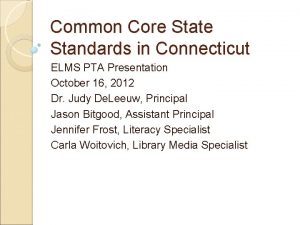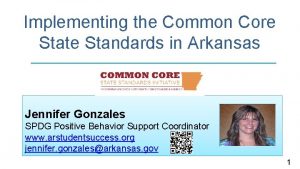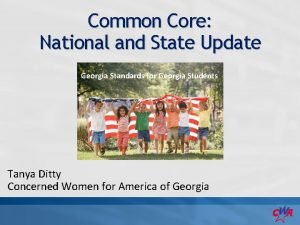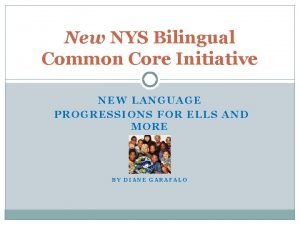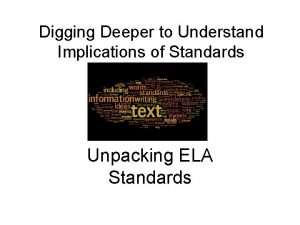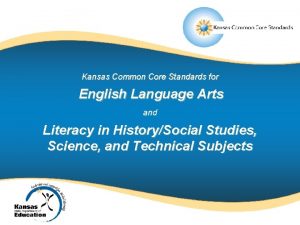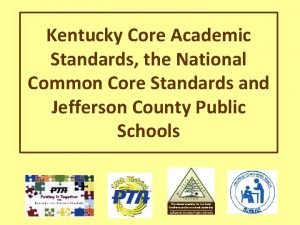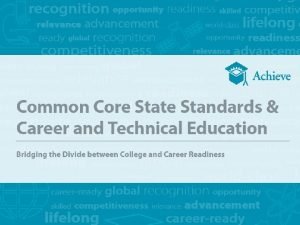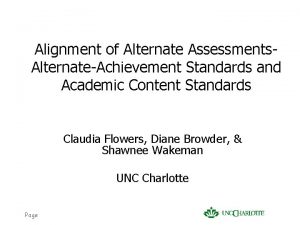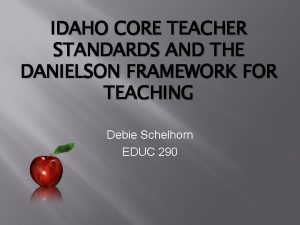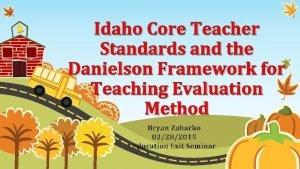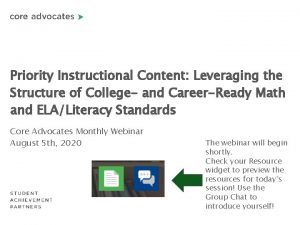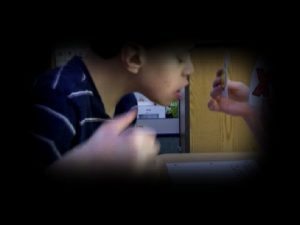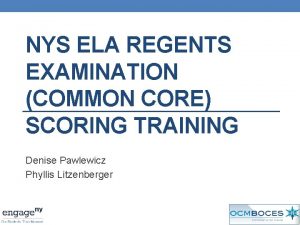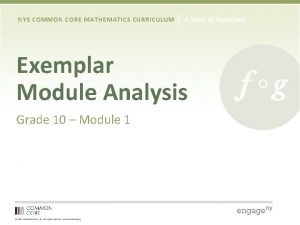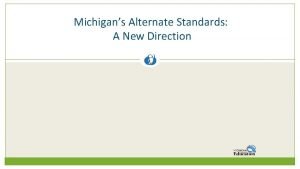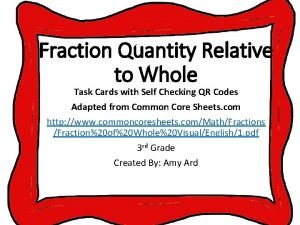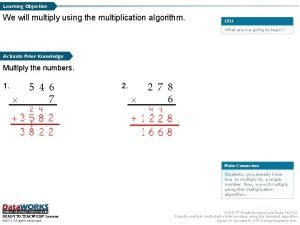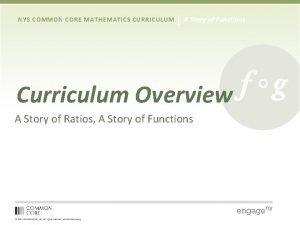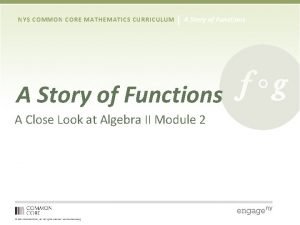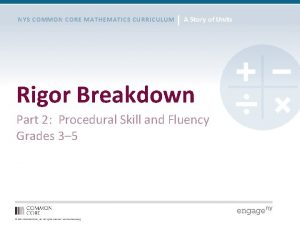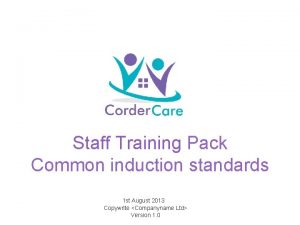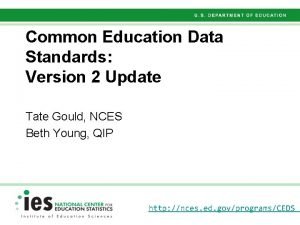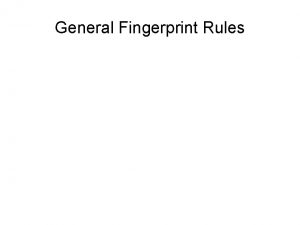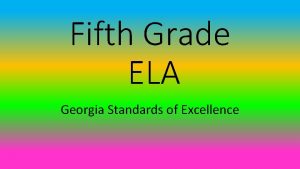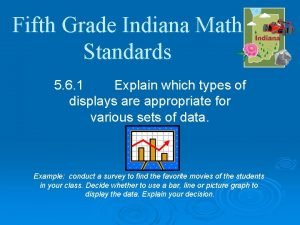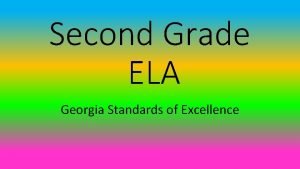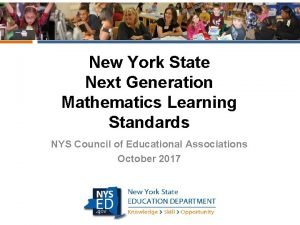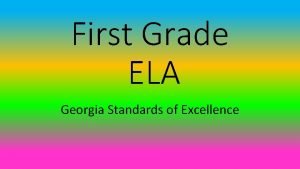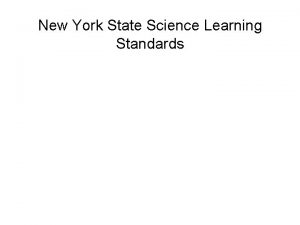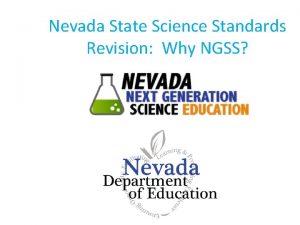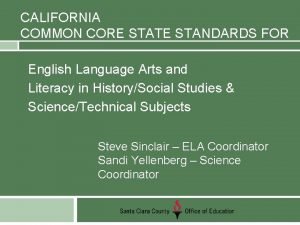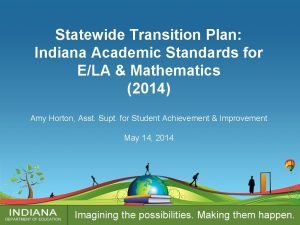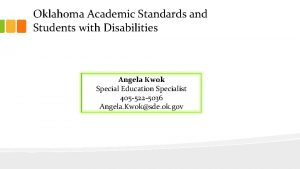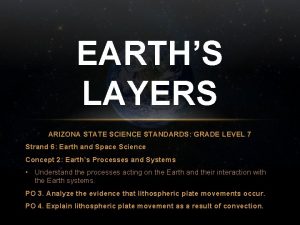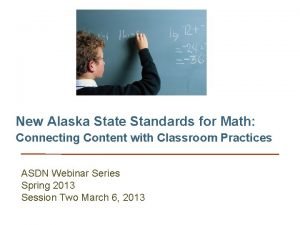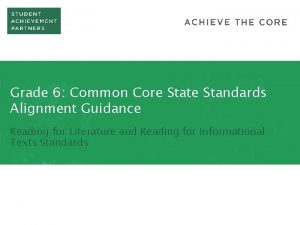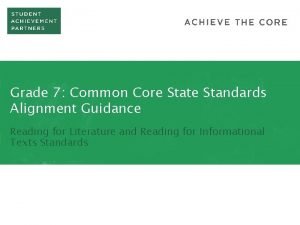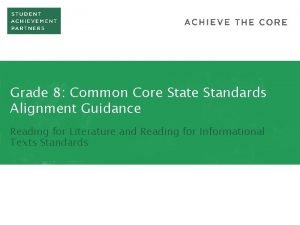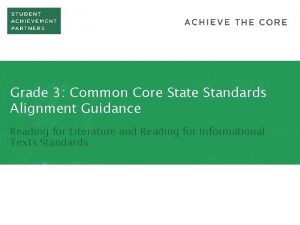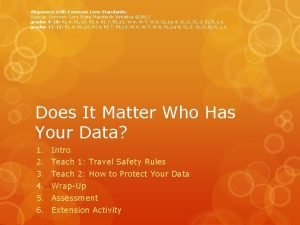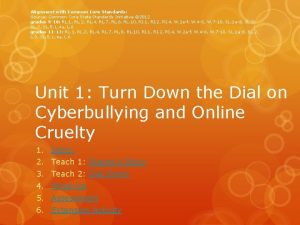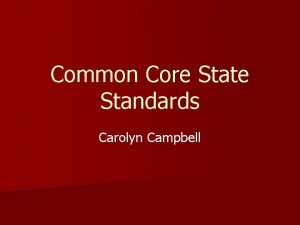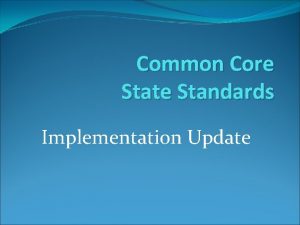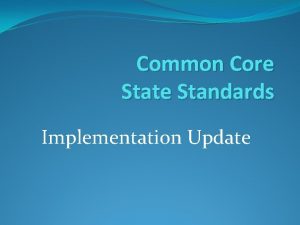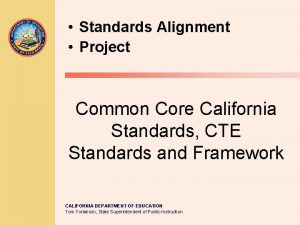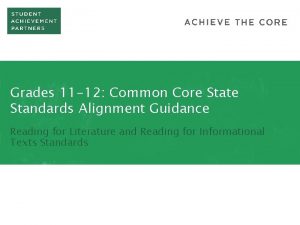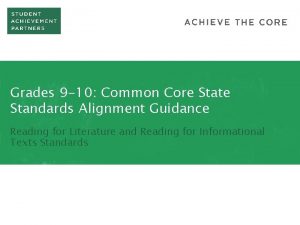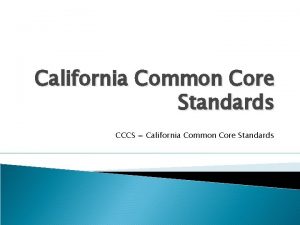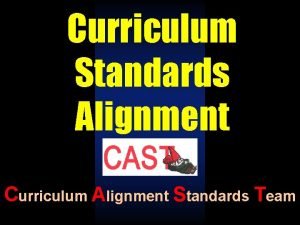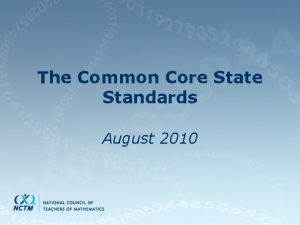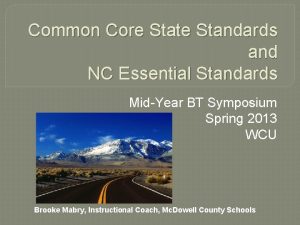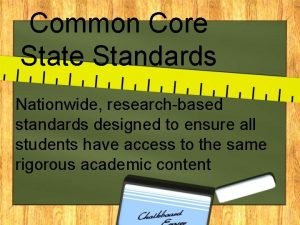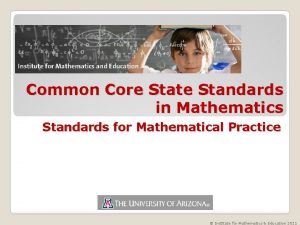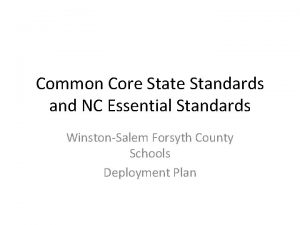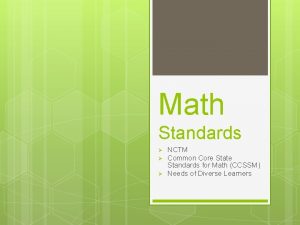Grade 4 Common Core State Standards Alignment Guidance

































































- Slides: 65

Grade 4: Common Core State Standards Alignment Guidance Reading for Literature and Reading for Informational Texts Standards

Session Objective The purpose of these materials is to help develop understanding of the expectations of high-quality summative assessment items. The concepts shown throughout these modules can be useful for classroom questioning and assessment, but the items themselves may need to be slightly modified. PAGE 2

Reading Standards for Literature

Links to Associated Literary Texts The literary sample items are written to the texts linked below. To better understand the points made in each item, you should familiarize yourself with each text. • Walk Two Moons by Sharon Creech • Yang the Eldest and His Odd Jobs by Lensey Namioka and Out of the Dust by Karen Hesse PAGE 4

Diving into the Specific Grade-Level Standards Remember that Standards 1 and 10 are bookends requiring: • all passages to be appropriately complex • all items to be answered using textual evidence Items should never be aligned to Standard 1 only. Instead, items should be aligned to Standard 1 and at least one other standard. PAGE 5

CCSS. ELA-Literacy. RL. 4. 2 Determine a theme of a story, drama, or poem from details in the text; summarize the text. PAGE 6

Which sentence best tells what the story is about? A. A family trip B. A relationship C. A beautiful natural event D. The role of park rangers Associated text: Walk Two Moons by Sharon Creech PAGE 7

The following question has two parts. Answer Part A and then answer Part B. Part A: Which statement best describes a main theme of the story? A. We should be generous to our loved ones. B. Life can be exciting at any age. C. Staying safe is more important than having adventures. D. The childhood years are the best in life. Part B: Which character from the story acts as the best example of the correct answer to Part A? A. Sal B. the ranger C. Gramps D. Gram Associated text: Walk Two Moons by Sharon Creech PAGE 8

Drag and drop the sentences into the correct order to summarize the excerpt from Walk Two Moons. The narrator notices that many different people are waiting for Old Faithful to erupt. Gramps teases Gram about how excited she is after she sees Old Faithful. The narrator worries that Gram is going to be disappointed in Old Faithful. A park ranger makes Gram move back behind the ropes around Old Faithful. Associated text: Walk Two Moons by Sharon Creech PAGE 9

Which central idea from the text should be referenced when creating a complete summary of the excerpt from Walk Two Moons? A. “‘I’ve waited my whole entire life to see Old Faithful. ’” B. “I was afraid Gram was going to be disappointed because it didn’t look like much at first. ” C. “Everyone stared at the hole. ” D. “‘Gol-dang—” Gramps said. “What’s the matter? ’” Associated text: Walk Two Moons by Sharon Creech PAGE 10

CCSS. ELA-Literacy. RL. 4. 3 Describe in depth a character, setting, or event in a story or drama, drawing on specific details in the text (e. g. , a character’s thoughts, words, or actions). PAGE 11

Click on the sentence in paragraph 19 that the author uses to show what Gram thinks about Old Faithful. Paragraph 19 provided below for reference: More steam, boiling and hissing, and a huge jing-bang spray of water surged out, climbing and climbing, and then more and more, until it looked like a whole river of water was shooting straight up into the air. “It looks like an upsidey-down waterfall!” Gram said. All the while there was a walloping hissing, and I could have sworn the ground rumbled and trembled underneath us. The warm mist blew toward us and people started backing away. Associated text: Walk Two Moons by Sharon Creech PAGE 12

When the family first arrives at Old Faithful, Sal says, “I was afraid Gram was going to be disappointed because it didn’t look like much at first. ” Circle three paragraphs that show that Gram was not disappointed in Old Faithful. Associated text: Walk Two Moons by Sharon Creech PAGE 13

CCSS. ELA-Literacy. RL. 4. 4 Determine the meaning of words and phrases as they are used in a text, including those that allude to significant characters found in mythology (e. g. , Herculean). PAGE 14

Which two words for the text are nonsense words rather than real words? A. Scrabbly B. Ma’am C. Gol-dang D. smooching E. Jing-bang F. Hissing Associated text: Walk Two Moons by Sharon Creech PAGE 15

The following question has two parts. Answer Part A and then answer Part B. Part A: In paragraph 19, what does the phrase surged out mean? A. suddenly rose higher B. increased in width C. rapidly got hot D. grew much louder Part B: Which two phrases from paragraph 19 best help the reader to know the meaning of surged out? A. “more steam” B. “boiling and hissing” C. “climbing and climbing” D. “whole river of water” E. “straight up into the air” F. “three feet high” Associated text: Walk Two Moons by Sharon Creech PAGE 16

Read this sentence from the excerpt from Walk Two Moons. “Then it was like the radiator boiling over or the tea kettle blowing its top. ” What type of figurative language does the writer include in this sentence? A. Personification B. Metaphor C. Symbolism D. Simile Associated text: Walk Two Moons by Sharon Creech PAGE 17

Read this sentence from paragraph 17 of Walk Two Moons. “Then it was like the radiator boiling over or the tea kettle blowing its top. ” What does this sentence help the reader understand about Old Faithful? A. The eruption is very powerful and loud. B. The heat from the eruption can be felt far away. C. The solid top of the geyser lifts up off the base when it erupts. D. They geyser can be used for cooking or to create energy. Associated text: Walk Two Moons by Sharon Creech PAGE 18

CCSS. ELA-Literacy. RL. 4. 5 Explain major differences between poems, drama, and prose, and refer to the structural elements of poems (e. g. , verse, rhythm, meter) and drama (e. g. , casts of characters, settings, descriptions, dialogue, stage directions) when writing or speaking about a text. PAGE 19

The box below includes five statements about the structures of Yang the Eldest and His Odd Jobs and Out of the Dust. Decide if each statement is true or false and place a check in the correct box next to each statement. TRUE FALSE Statement Both texts use rhyme. Both texts use chronological order. Both texts have verses. Both texts use dialogue. Associated texts: Yang the Eldest and His Odd Jobs by Lensey Namioka and Out of the Dust by Karen Hesse PAGE 20

Which statement best explains how Text 1 and Text 2 convey events? A. Text 1 uses mostly dialogue to show the children plot to help Eldest Brother, while Text 2 uses rhythmic stanzas to capture thoughts of the narrator to emphasize the soothing nature of piano playing to her. B. Text 1 uses dialogue and stage directions to provide insight into the characters’ thoughts, while Text 2 uses repeated words and phrases to show music follows patterns. C. Text 1 uses descriptions from an outsider’s point of view, while Text 2 uses rhyming verse to provide insight into how the audience reacts to the music. D. Text 1 uses long speeches to help get the characters’ thoughts across to the reader, while Text 2 uses short lines to show that the narrator is simply enjoying playing music and not thinking too deeply about the experience. Associated texts: Yang the Eldest and His Odd Jobs by Lensey Namioka and Out of the Dust by Karen Hesse PAGE 21

CCSS. ELA-Literacy. RL. 4. 6 Compare and contrast the point of view from which different stories are narrated, including the difference between first- and third-person narrations. PAGE 22

The following question has two parts. Answer Part A and then answer Part B. Part A: Which statement below describes the point of view of Yang the Eldest and his Odd Jobs? A. First-person point of view, with the narrator being a concerned child B. First-person point of view, with the narrator being a worried adult C. Third-person point of view, with the narrator knowing everything that each character is thinking D. Third-person point of view, with the narrator only knowing what the characters say through dialogue Part B: Which statement below describes the point of view of Out of the Dust? A. First-person point of view, with the narrator being a parent B. First-person point of view, with the narrator being the one performing C. Third-person point of view, with the narrator knowing everything the piano player is thinking D. Third-person point of view, with the narrator being an a member of the audience Associated texts: Yang the Eldest and His Odd Jobs by Lensey Namioka and Out of the Dust by Karen Hesse PAGE 23

Think about who is telling the story about Eldest Brother and who is speaking in the poem. Write an essay comparing the person who tells the story to the person who is speaking in the poem, describing how each helps the reader understand the characters of Eldest Brother and Billie Jo and their love of music. Use details from both texts to support your response. Associated texts: Yang the Eldest and His Odd Jobs by Lensey Namioka and Out of the Dust by Karen Hesse PAGE 24

CCSS. ELA-Literacy. RL. 4. 7 Make connections between the text of a story or drama and a visual or oral presentation of the text, identifying where each version reflects specific descriptions and directions in the text. PAGE 25

You have read an excerpt from Out of the Dust. Now watch the video below of a student’s presentation of the book. https: //www. youtube. com/watch? v=T 2 rtj 2 l. Gd. Rg What three pieces of information does the video provide that the poem does not? A. What Billie Jo looks like B. The fact that Billie Jo likes to play piano C. That Billie Jo likes apples D. That Billie Jo’s hands had been injured E. That people enjoy listening to Billie Jo play piano F. What musical instrument Billie Jo plays G. That Billie Jo plays for audiences Associated stimuli: Out of the Dust by Karen Hesse and video “Out of the Dust Book Trailer” PAGE 26

You have read an excerpt from Out of the Dust. Now watch the video below of a student’s presentation of the book. https: //www. youtube. com/watch? v=T 2 rtj 2 l. Gd. Rg How do the details provided in the video help the reader understand why, in the poem, Billie Jo refers to piano playing as “supremely heaven”? A. They explain that Billie Jo likes to be the center of attention. B. They explain how talented Billie Jo is and how much people like to hear her play. C. They explain how bad the conditions are in Billie Jo’s life and why she appreciates being able to play. D. They explain how proud Billie Jo’s family is of her and her talent. Associated stimuli: Out of the Dust by Karen Hesse and video “Out of the Dust Book Trailer” PAGE 27

CCSS. ELA-Literacy. RL. 4. 8 Standard 8 does not apply to literature PAGE 28

CCSS. ELA-Literacy. RL. 4. 9 Compare and contrast the treatment of similar themes and topics (e. g. , opposition of good and evil) and patterns of events (e. g. , the quest) in stories, myths, and traditional literature from different cultures. PAGE 29

Which topic is shared by both the text and the poem? A. An injury that has prevented a character from playing an instrument B. The relationship between a character and a brother or sister C. The love a character has for playing an instrument D. The importance a character places on having friends for support Associated texts: Yang the Eldest and His Odd Jobs by Lensey Namioka and Out of the Dust by Karen Hesse PAGE 30

From the list of themes, choose the main theme shared by Yang the Eldest and His Odd Jobs and Out of the Dust and drag it in the correct place on the chart. Then, choose one statement from Text 1 and one statement from Text 2 that support this theme. Drag the supporting statements to their correct place on the chart. Support from Main Theme in from Out Yang the Eldest Support Both Texts of the Dust and his Odd Jobs Themes Musicians enjoy being around each other. Musicians need a lot of admiration and support. Music can bring happiness to people’s lives. Musicians must practice in order to play well. PAGE 31

Item continued from the previous slide Support from Yang the Eldest and His Odd Jobs Support from Out of the Dust I thought about what Fourth Brother had said: Eldest Brother had to want to play again. Matthew was eager to be part of the plan. He had obviously practiced hard on the piece, and he went into it without having to worry about the notes. I glanced at Eldest Brother and saw that tears were rolling down his cheeks. the music/springs straight out of me. and the rest, eyes shining/fingers snapping, It’s the best/ I’ve ever felt/playing hot piano, swinging with the Black Mesa Boys, Associated texts: Yang the Eldest and His Odd Jobs by Lensey Namioka and Out of the Dust by Karen Hesse PAGE 32

Bottom Line for Reading for Literature Standards Questions are – based on texts that are of appropriate complexity. They are worthy of students’ attention. (Standard 10) Questions require – students to read closely and think deeply about key ideas and specifics of the texts. They are questions worth answering. – students to use textual evidence to help them formulate their responses. They help prepare students for the demands of careers and college. (Standard 1) PAGE 33

Reading Standards for Informational Text

Links to Associated Informational Texts The informational items are written to the texts linked below. To better understand the points made in each item, you should familiarize yourself with each text. • Basic Archaeology “What’s in a Dig? ” and “What’s in a Midden? ” by David White PAGE 35

Diving into the Specific Grade-Level Standards Remember that Standards 1 and 10 are bookends requiring: • all passages to be appropriately complex • all questions to be answered using textual evidence PAGE 36

CCSS. ELA-Literacy. RI. 4. 2 Determine the main idea of a text and explain how it is supported by key details; summarize the text. PAGE 37

Which sentence states the main idea of “What’s a Midden? ” A. Conquering other people destroys details about the past. B. Learning about the past is more important than ever. C. Being an archaeologist is a very difficult job. D. Looking at old trash gives archaeologists useful knowledge. Associated texts: Basic Archaeology: “What’s a Dig? ” and “What’s a Midden? ” by David White PAGE 38

The following question has two parts. Answer Part A and then answer Part B. Part A: Which sentence states the main idea of “What’s a Midden? ” A. Conquering other people destroys details about the past. B. Learning about the past is more important than ever. C. Being an archaeologist is a very difficult job. D. Looking at old trash gives archaeologists useful knowledge. Part B: Which detail from the article best supports the correct answer to Part A? A. “By sifting through the garbage pile of a civilization, archaeologists can find out what was important to those people (or what they had too much of). ” B. “Sometimes, garbage is all that's left of a people. ” C. “Especially if that people has been conquered by others, the buildings, tools, and food were probably consumed or destroyed long ago. ” D. “Some invaders, not really knowing what's valuable to the people they're conquering, might very well throw away things that are extremely valuable. ” Associated texts: Basic Archaeology: “What’s a Dig? ” and “What’s a Midden? ” by David White PAGE 39

“What’s a Dig? ” provides important information related to archaeology. Place the topics into the order in which they were presented by dragging and dropping the topics into the right place in the table below. How trash becomes buried What can be learned about the past What tools archaeologists use What a dig is Associated texts: Basic Archaeology: “What’s a Dig? ” and “What’s a Midden? ” by David White PAGE 40

Which pair of sentences provides the best summary of “What’s a Dig? ” A. Archaeologists want to learn about different people. They study the things these people leave behind in order to learn more about them. B. Seeds, clothing, and trash tell us how our lives today are like the lives of people in the past. Archaeologists dig up these things and look at them closely to determine how people of the past used them. C. Bad weather and fires caused people of the past to bury their belongings. Archaeologists used special tools to dig up those belongings to determine what happened to the people. D. Archaeologists are people who dig for clues that will tell them how people of the past once lived. There are many types of clues that have become buried by layers of dirt over time, and tools can be used to find them on a dig site. Associated texts: Basic Archaeology: “What’s a Dig? ” and “What’s a Midden? ” by David White PAGE 41

CCSS. ELA-Literacy. RI. 4. 3 Explain events, procedures, ideas, or concepts in a historical, scientific, or technical text, including what happened and why, based on specific information in the text. PAGE 42

Which sentence from “What’s a Dig? ” best describes the importance of a dig? A. “Well, first of all, the wind is constantly blowing fresh dirt and trash all over the world. ” B. “After years of these tiny layers building up, what was once on the surface is buried underground. ” C. “Also, a dig might turn up fragments of clothing or shoes, giving archaeologists clues to what kind of clothing the people who lived there wore. ” D. “The basic idea behind the dig is to discover the past. ” Associated texts: Basic Archaeology: “What’s a Dig? ” and “What’s a Midden? ” by David White PAGE 43

The following question has two parts. Answer Part A and then answer Part B. Part A: According to “What’s a Dig? ”, what do archaeologists study in addition to people who lived long ago? A. The reasons an area became full of debris long ago B. The general conditions in an area long ago C. The governments of the people long ago D. The ways people worked together long ago Part B: Which detail from “What’s a Dig? ” best supports the correct answer to Part A? A. “It's not that the ground has really sunk; it's more that more layers have been added on top. ” B. “And the more they find, the more they understand. ” C. “For instance, by discovering seeds, archaeologists can also discover what kinds of crops the people who lived there grew or, if people didn't live there at all, what kind of wild plants or fruits or vegetables grew there. ” D. “Also, a dig might turn up fragments of clothing or shoes, giving archaeologists clues to what kind of clothing the people who lived there wore. ” Associated texts: Basic Archaeology: “What’s a Dig? ” and “What’s a Midden? ” by David White PAGE 44

CCSS. ELA-Literacy. RI. 4. 4 Determine the meaning of general academic and domain-specific words and phrases in a text relevant to a grade 4 topic or subject area. PAGE 45

Which set of words from “What’s a Dig? ” are opposites of each other? A. “designed, ” “patterns” B. “skeleton, ” “remains” C. “surface, ” “underground” D. “debris, ” “trash” Associated texts: Basic Archaeology: “What’s a Dig? ” and “What’s a Midden? ” by David White PAGE 46

In paragraph 2 of “What’s a Dig? ” which two words help the reader understand what the word debris means? A. wind B. dirt C. trash D. ground E. layers F. surface Associated texts: Basic Archaeology: “What’s a Dig? ” and “What’s a Midden? ” by David White PAGE 47

CCSS. ELA-Literacy. RI. 4. 5 Describe the overall structure (e. g. , chronology, comparison, cause/effect, problem/solution) of events, ideas, concepts, or information in a text or part of a text. PAGE 48

The author of “What’s a Midden? ” compares a midden to “a garbage pile of a civilization. ” What is the point of this comparison? A. to show that throughout history people have been wasteful B. to explain what types of things may be found in middens and why C. to argue that the things found in middens are worthless D. to demonstrate that valuable things often get thrown away Associated texts: Basic Archaeology: “What’s a Dig? ” and “What’s a Midden? ” by David White PAGE 49

Which sentence best describes the overall structure of the video? A. The video uses comparison/contrast to describe how an archaeologist’s job is different from what most people believe the job is like. B. The video uses cause/effect to explain why certain objects were made from various materials. C. The video uses main idea and supporting detail to describe what an archaeologist does with various tools and then provides specific examples of artifacts. D. The video uses sequence of events to explain the steps used to find buried artifacts and how those artifacts are then displayed. Associated stimulus: video “Archaeologists - Career Spotlight” https: //kids. usa. gov/watchvideos/jobs/archeologist/index. shtml PAGE 50

CCSS. ELA-Literacy. 4. 6 Compare and contrast a firsthand secondhand account of the same event or topic; describe the differences in focus and the information provided. PAGE 51

The following question has two parts. Answer Part A and then answer Part B. Part A: Which stimulus in this set is a firsthand account of the role of archaeologists? A. Article 1 B. Article 2 C. The video Part B: What aspect of the stimulus chosen in Part A tells you it is a firsthand account? A. The stimulus asks questions for the reader to think about. B. There are people talking about the experiences they have had. C. There are examples of things that may be found at a dig. D. The stimulus contains words that help the reader understand scientific terms. Associated stimuli: Basic Archaeology: “What’s a Dig? ” and “What’s a Midden? ” by David White and video “Archaeologists – Career Spotlight” https: //kids. usa. gov/watch-videos/jobs/archeologist/index. shtml PAGE 52

What topic is more fully explained by the speakers in the video than by the writer of the texts? A. B. C. D. how the tools are actually used where middens are found how artifacts get buried why archaeologists dig for artifacts Associated stimuli: Basic Archaeology: “What’s a Dig? ” and “What’s a Midden? ” by David White and video “Archaeologists – Career Spotlight” https: //kids. usa. gov/watch-videos/jobs/archeologist/index. shtml PAGE 53

CCSS. ELA-Literacy. RI. 4. 7 Interpret information presented visually, or quantitatively (e. g. , in charts, graphs, diagrams, time lines, animations, or interactive elements on Web pages) and explain how the information contributes to an understanding of the text in which it appears. PAGE 54

Write an explanatory essay explaining the purpose of the video you have watched on archaeology. Why would the makers of the video want children to view it? What do they want students to learn? Be sure to use details and examples from the video as you write your response. Associated stimuli: video “Archaeologists – Career Spotlight” https: //kids. usa. gov/watchvideos/jobs/archeologist/index. shtml PAGE 55

The following question has two parts. Answer Part A and then answer Part B. Part A: Which question from Article 2 is answered by the video regarding the people who lived at Best Farm? A. “What’s a Midden? ” B. “Did they wear certain clothes? ” C. “What kinds of food did they eat? ” D. “What kind of tools did they use or throw away? ” Part B: Which example from the video best supports the correct answer to Part A? A. The old coin B. The button C. The pieces of pottery D. The shells and animal bones Associated stimuli: Basic Archaeology: “What’s a Dig? ” and “What’s a Midden? ” by David White and video “Archaeologists – Career Spotlight” https: //kids. usa. gov/watch-videos/jobs/archeologist/index. shtml PAGE 56

CCSS. ELA-Literacy. RI. 4. 8 Explain how an author uses reasons and evidence to support particular points in a text. PAGE 57

What type of evidence does the author use in “What’s a Dig? ” to show that digs provide valuable information about people of the past? A. Quotations from experts who have been on a dig B. Examples of items that could be found at a dig C. Specific descriptions of items he has actually found at a dig D. A scientific explanation of the process used at a dig Associated texts: Basic Archaeology: “What’s a Dig? ” and “What’s a Midden? ” by David White PAGE 58

Read the following sentence from “What’s a Midden? ” “A people's trash, especially if it was also trash to the invaders, might be left alone, enabling archaeologists to discover more about a people who left few clues to what they liked and didn't like. ” Which point is the author supporting by including this sentence in the article? A. how difficult it is to learn about people based on the objects they have left behind B. that objects that were considered worthless in the past are also worthless in the present C. that throughout history people have fought over valuable objects D. why some objects people used in the past may have survived to the present Associated texts: Basic Archaeology: “What’s a Dig? ” and “What’s a Midden? ” by David White PAGE 59

CCSS. ELA-Literacy. RI. 4. 9 Integrate information from two texts on the same topic in order to write or speak about the subject knowledgeably. PAGE 60

What subject is mentioned by both of the articles and the video? A. the importance of objects left behind B. specific items found at a dig C. the role conquering people played in creating middens D. specific tools used by archaeologists Associated texts: Basic Archaeology: “What’s a Dig? ” and “What’s a Midden? ” by David White PAGE 61

The column on the left lists some important ideas about archaeologists. One idea is found in both articles. One idea is found in “What’s a Dig” only, and one idea is found in “What’s a Midden? ” only. Write the ideas in the correct columns below. One idea will not be used. Because of the length of the question, the item continues on the next slide. Associated texts: Basic Archaeology: “What’s a Dig? ” and “What’s a Midden? ” by David White PAGE 62

Item continued from the previous slide Important Ideas About Archaeologists Both Articles “What’s a Midden? ” Archaeologists dig in the ground because old objects are found underground. An archaeologist’s job is to learn about what things were like in the past. An archaeologist has to work slowly and carefully so that clues are not damaged. Archaeologists learn a lot about the past by digging in buried trash. “What’s a Dig? ” Associated texts: Basic Archaeology: “What’s a Dig? ” and “What’s a Midden? ” by David White PAGE 63

Bottom Line for Reading for Information Standards Questions are – based on texts that are of appropriate complexity. They are worthy of students’ attention. (Standard 10) Questions require – students to read closely and think deeply about key ideas and specifics of the texts. They are questions worth answering. – students to use textual evidence to help them formulate their responses. They help prepare students for the demands of careers and college. (Standard 1) PAGE 64

Thank You!
 Unpacking common core standards
Unpacking common core standards Common core state standards ct
Common core state standards ct Common core state standards missouri
Common core state standards missouri Common core standards arkansas
Common core standards arkansas Global alignment
Global alignment Pam1250
Pam1250 Sequence alignment
Sequence alignment Global and local alignment
Global and local alignment Global vs local alignment
Global vs local alignment Georgia common core standards
Georgia common core standards New language arts progressions
New language arts progressions Unpack standards template
Unpack standards template Kansas english standards
Kansas english standards Kcas standards
Kcas standards Common career technical core
Common career technical core 4th grade math jeopardy common core
4th grade math jeopardy common core Cuspal angle
Cuspal angle Direct guidance techniques
Direct guidance techniques Alternate standards alignment
Alternate standards alignment The brittle, rocky outer layer of earth
The brittle, rocky outer layer of earth Earth mantle definition
Earth mantle definition Crust outer core inner core mantle
Crust outer core inner core mantle Purpose of paradox
Purpose of paradox National core standards assessment tools
National core standards assessment tools Idaho core teaching standards
Idaho core teaching standards Idaho core teaching standards
Idaho core teaching standards Achieve the core priority standards
Achieve the core priority standards Utah core math standards
Utah core math standards Customer service standards table
Customer service standards table Common core essential elements
Common core essential elements Regents part 3 rubric
Regents part 3 rubric Nys common core
Nys common core Essential elements michigan
Essential elements michigan Fraction quantity relative to whole
Fraction quantity relative to whole Common core formative assessments
Common core formative assessments Common core lattice multiplication
Common core lattice multiplication Whats common
Whats common Lesson 11 transforming the graph of the sine function
Lesson 11 transforming the graph of the sine function Nys common core mathematics curriculum
Nys common core mathematics curriculum Common core ela assessments
Common core ela assessments Common induction standards
Common induction standards Common education data standards
Common education data standards Greatest common factor least common multiple
Greatest common factor least common multiple Common anode and common cathode
Common anode and common cathode Factors of 60 and 72
Factors of 60 and 72 Highest common factors and lowest common multiples
Highest common factors and lowest common multiples Lcm of 4 8 and 16
Lcm of 4 8 and 16 Multiples of 9 and 21
Multiples of 9 and 21 What are the rules in the selection of core and delta
What are the rules in the selection of core and delta Properties of core of the earth
Properties of core of the earth 5th grade writing standards georgia
5th grade writing standards georgia Indiana state standards math
Indiana state standards math Georgia ela standards
Georgia ela standards Nys next generation standards math
Nys next generation standards math Oklahoma 3rd grade math standards
Oklahoma 3rd grade math standards Elagse
Elagse New york state learning standards science
New york state learning standards science Nevada state science standards
Nevada state science standards Social emotional learning standards washington state
Social emotional learning standards washington state California content standards english
California content standards english Termidoe
Termidoe Pendiana
Pendiana Strrea
Strrea Arizona state science standards
Arizona state science standards California state standards physical education
California state standards physical education Alaska state standards math
Alaska state standards math

